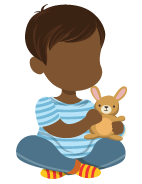Practical support for identifying and meeting need
Communication and interaction
What are social communication needs?
Some children and young people have differences with their social communication and interaction, for example they may:
- process information differently (especially the spoken word)
- find inference confusing
- have interests that their peers do not share
- still be developing their ‘Theory of Mind’ (our ability to see another’s perspective)
- have social interactions that are different to some of their peers
- find it hard to consider the perspective of an individual with social interaction and communication needs which can lead to a difficulty with reaching a common understanding of one another
- find it difficult to work alongside other children which could result in an increase in stress levels or inappropriate behaviour
- display empathy in different situations to what may be expected; this can mean that there are times when they are unaware of other people’s feelings or find it hard to understand another person’s perspective
- have difficulty reading facial expressions and body language
- find playtimes and lunchtimes stressful. This can be due to the lack of structure and routine or because they have difficulty interpreting and using the unwritten rules of social interaction
- find team games and sports challenging.
Difficulties encountered by children with social communication needs
Children with social communication needs may find it difficult to work alongside other children and this could result in an increase in stress levels or inappropriate behaviour. Some individuals may display empathy in different situations to what may be expected; this can mean that there are times when they are unaware of other people’s feelings or find it hard to understand their perspective. They may also have difficulty reading facial expressions and body language.
Playtimes and lunchtimes can be stressful for some children. This can be due to the lack of structure and routine or because they have difficulty interpreting and using the unwritten rules of social interaction. Team games and sports can also be challenging for a child who has difficulty with social interaction.
Many children with social communication needs experience sensory difficulties. Some of these difficulties are immediately apparent but others can be less obvious. These can result in an unexpected or inappropriate response to sensory stimuli with children being over or under sensitive to sight, sound, smell, taste, touch. Find out more about sensory needs >
Some children may also have difficulty with motor coordination which can make them appear uncoordinated and affect their ability and performance in PE lessons, sports activities or general movement around the classroom. Find out more about physical needs >
Some children and young people with communication and social interaction needs may receive a diagnosis of Autism. Find out more >
How to spot children with social communication needs in the school setting
Every child and young person’s social communication needs will be unique to them. In addition, we know that behaviour is a form of communication, therefore we must keep this in mind when considering how to respond in situations that may arise. It is imperative that we know the young person in order to plan how we can best support them.
Gather information from the young person, family and school staff who know them well to form a picture of the child or young person’s strengths and needs, noting:
- difference in social interactions/difficulties with social communication, e.g. making and keeping friends, socially isolated or has key friends
- ability to understand other people’s feelings
- ‘masking’ i.e. conforming in school but displaying unhappiness in other settings (e.g. at home)
- quiet/withdrawn
- sensory differences
- expressions of feeling overwhelmed
- signs of anxiety
- passionate interests
- avoidance of eye contact
- interpretation of situations, e.g. taking comments literally
- rigidity of thoughts which affects learning and may affect being a member of a group in some contexts
- difficulty with understanding language and communicating
- response to simple instructions in context/processing of verbal information
- method of communicating need both verbal and non-verbal
- ability to sustain listening concentration
- response to change
Practical ideas and strategies
Behaviours and areas of need you might see in the classroom and approaches to try.
For additional information you can also look in the ‘Blue Book‘
Coping with day to day changes and transitions
- Use of a personalised visual timetable to make the day predictable. Remove each picture in the sequence when the activity has been completed and place in a ‘finished’ box.
- Include a ‘change’ option on the timetable to show a change in the daily routine when appropriate e.g. lessons missing or in a different order; trips; Christmas activities; concerts; visitors to class or school.
- Try to give as much advance warning as possible and prepare them for the change.
- Make sure the timetable is clearly visible either for the individual child or for the whole class – consider height and location.
- Visual timetables can be made using symbols, photographs or a written list and can be used with the whole class as part of their daily routine or as a smaller discreet individual timetable.
- Try a timetable strip on the wall with a plastic pocket underneath to hold each picture symbol when ‘finished’ or an A4 envelope folder with Velcro strips on the flap and place the symbols inside the folder when ‘finished’.
- Give warnings for finishing activities and include instructions for tidying up if appropriate e.g. allocate a specific job such as collecting pencils, putting bricks in the box or cleaning tables. Warnings for the end of playtime and lunchtime may help prepare them for coming back into school.
Understanding classroom talk
There are general ideas on how to support children’s understanding of classroom talk on the speech and language page >
With children and young people who have social communication needs you may also need to consider the following.
- Remember that sarcasm or humour may not be understood and could cause confusion. Jokes may need to be explained especially if they are a ‘play on words’ (puns). Avoid using sarcasm, irony and banter unless you are able to develop the child’s understanding – explain exactly what you mean in an age appropriate way.
- Consider what may be taken literally or misinterpreted – is there a clearer way to say it?
- It is best to say what you mean and mean what you say.
- Body language, facial expressions and subtle gestures are not always interpreted correctly or picked up on at all – don’t rely on them to get your message across, but support the child in understanding their meaning.
- Eye contact is not a guarantee that a child is listening or paying attention. Insisting on eye contact may impact on the sensory processing system and actually prevent effective listening.
Making friends
- Support for playtimes and lunchtimes – share appropriate strategies with lunchtime staff. Teach the rules of simple games to all the children so the child knows what is expected.
- Teach appropriate social skills either as part of the curriculum or through specific social skills programmes e.g. Socially Speaking, Time to Talk.
- Give support to help understand friendship – what a friend is, how to make and keep friends.
- Give an explanation of how other people may be feeling and why e.g. X is crying because Y said she couldn’t join and she feels sad about it. It may be helpful to talk about emotions and expressions e.g. as part of sharing books together, discussion of stories.
- Social stories can help a child to understand a specific social situation. Find out more > (National Autistic Society website)
- Circle of friends is an approach that involves an individual’s peers supporting them to learn strategies and overcome barriers and behaviours that they are finding difficult. It is a structured and planned approach. For more information on this approach, talk to your Educational Psychologist or Specialist teacher.
- Lunchtime clubs or being a helper provide the opportunity for individuals with similar interests to come together over their shared passion. It also provides an element of structure to a period of time that could otherwise be quite open-ended and unpredictable. Providing an individual with a job or a role to do, especially during social times, can also help to provide structure and offers you the opportunity to teach interaction skills which you can then work towards generalising.
Working in a group
- Decide on the purpose of a task – is it intended to develop the child’s academic skills or social skills? Focusing on either the learning demands or the social demands rather than on both will help to reduce the child’s anxiety. Limit the number of children they are expected to work with – start with working in a pair then build up to a small group when appropriate.
- Adults give a commentary during activities to support a child’s social understanding e.g. X is looking very excited and really wants a turn.
- Adults model how to cope with situations within a group e.g. Can I have the glue please?
- Provide opportunities to work on group skills when these are the main focus e.g. board games, ball games, rather than where the main focus is the curriculum content
- Other ideas – taking turns, sharing, listening conch, talking about what’s important in group working – being explicit.
Coping when feeling overwhelmed or angry
- Consider the possible impact of sensory needs > on the child’s behaviour.
- Provide consistency – of routine, approach and language used and amongst staff as this will help the child to feel calm and secure.
- Record any outbursts, or times when an individual may withdraw using a structured recording method such as an ABC chart, or a STAR chart to establish any triggers or patterns to behaviour. It is helpful to consider the setting/time of day/environment as well as the behaviour that has been displayed. For more information please see the Blue Book >
- Allow access to a quiet, safe area for ‘time out’ to calm down when stressed, anxious or angry. This could be in another part of school, a separate area of the classroom or a small tent within the classroom.
- Reduce the language that you are using – this is not the time to be asking ‘why?’; often the child or young person is in a heightened state of emotion and their processing skills reduce. Using minimal language, or using visual supports instead, will reduce demands on the individual.
Motivation and behaviour
- Give positive instructions rather than saying what not to do and repeat instructions using the same clear, simple language. Telling a child what not to do will leave them not knowing what they should do instead e.g. say ‘hands down’ rather than ‘no scratching’.
- Be clear about your expectations and how you pass on this information to them, or to other staff, so they know where they are expected to be and what they should be doing e.g.task to be completed and consequence or reward, what will happen next. This can be particularly important at transition times and between activities when there is less structure/routine to follow.
- Offer choices when appropriate. Specify choices of activities available at appropriate times such as: free choice sessions; short periods of time available between activities, prior to playtime, at the end of the day; equipment available on the playground (include any rules about class rotas or designated areas for equipment use). Present the options visually e.g. on a small strip or board.
- Give a rewarding activity when a required task has been completed or use a sticker chart. Find out what motivates them – your idea of a reward may not be theirs!
- Use any special interest the child may have as a motivator e.g. a child who likes dinosaurs may respond well to writing on paper with a dinosaur border or engage in numeracy tasks if they can be related to dinosaurs. Read more from ‘Nothing about me without me’.
- Involve them in making and personalising things such as ‘finished‘ boxes, timetables or sticker charts – this will help to give them involvement in, and ownership of, strategies to manage their behaviour.
- Give specific praise – children need to know what they are doing well so they can repeat it. Examples of specific praise are: “I really liked that you put your hand up and waited for me to ask you a question”, “It was good that you used your number work from yesterday to help you solve today’s maths problems”, “You are sitting really well on your chair because all four of the chair legs are on the floor – well done”. “I really liked that you let Jemma finish what she was saying before you shared what you were thinking”
- Do not promise what you cannot deliver – consider the time available and the appropriateness of the activity when offering a reward e.g. it may be unrealistic to offer painting five minutes before the end of a session or time spent in another room if others may be working there.
- Follow through with any ‘promises’ made – comments like ‘if there’s time; at the end of the lesson; in a minute; tomorrow’ may be interpreted as something that will definitely happen and could cause problems if the thing that is promised does not actually happen.
- Make your expectations clear, realistic and achievable.
- Recognise that some children may need to know ‘why?’ and will require more detailed explanations, information or instructions and may need to see the bigger picture.
- Consider the use of extrinsic rewards to motivate and engage an individual. Not all children are motivated to please the adult in a situation by responding in a particular way so the use of motivators which are relevant to the individual is important. Using extrinsic rewards does not give the individual ‘something extra’ as they are not experiencing the same feedback by pleasing the adults as others.
Concentration and learning
Consider the possible impact of sensory needs on the child’s concentration and focus.
- Use visual supports whenever possible to provide a constant, concrete reminder – timetable; work schedule; class/school/playground rules; label areas of the room/equipment; a timer to show time available/ left for an activity; use lists/ photographs/ drawings/prepared items to show what is expected for specific tasks. A ‘First/Then’ approach can be helpful. Find out more >
- Break down instructions for a task and present them visually so they are clear what they need to do e.g. listen to story, write three sentences, draw a picture. Use a whiteboard so they can cross or rub each part off as they complete it. This will also help them see that there is an end to the task. Use a timer to visually show how much time is left for the lesson or to finish a task. Visually organise the materials that are needed for a task. Whenever possible give visual supports to reinforce auditory information.
- Build up a routine of tasks followed by a rewarding activity to develop and extend attention span and promote independence e.g. register, trace letters, count then choice (offer a limited choice of activities that the child will find motivating).
- Use of an individual workstation/area may help them to focus on and complete tasks without becoming distracted. Having a work tray of differentiated activities and a ‘finished’ tray may also help them to complete tasks.
- Consider alternative forms of recording. Click here for ideas from the Communication Trust >
Coping with life changes and big events
- Develop an A4 Pen Portrait to create a profile of strengths, interests and needs and to share information with other staff. Update on a regular basis during the year and prior to transition times between classes or schools.
- Plan and implement a comprehensive, personalised transition package to prepare them for changes between classes and school settings.
- Work in partnership with parents and carers. It is important to remember that we all present and act differently across different environments. We often feel safer and more able to be true to ourselves in our home environment. Events that happen at home will inevitably influence what happens in school. Working closely with parents can be really helpful (link to Working in partnership section). Sharing the strategies and resources that work at home and in school can be really beneficial. There may also be times when families may benefit from support at home e.g. Early Help assessment.
Specialist – additional support for children and young people with an ongoing and significant identified need
Learning environment
- There is access to an environment where the social demands are reduced
- There is time to engage in a community activity
- Access to highly skilled/trained staff that are familiar with the needs of children and young people with social communication and interaction needs is available
- Alternative and augmentative communication are available if required. Alternative and augmentative communication >
- There is enhanced use of structure such as individual visual timetables, visual sequences and lists, workstations and rewards to develop independence
Access to the curriculum
- Teaching approaches are used that place a high emphasis on direct training, are differentiated appropriately and offer practical tasks which provide opportunities for frequent repetition and reinforcement
- Additional adult support is offered, under the direction of the teacher, to work on modified curriculum tasks/access regular individual support and promote independence
- Independent living skills are developed through access to targeted interventions
- Provision to meet sensory needs is in place, as appropriate and advised
- There is use of a flexible, personalised timetable and bespoke programme
- A significantly differentiated curriculum is offered with a high emphasis on social communication and social skills development incorporating specialist advice
- Advice from external agencies is implemented and recorded, including targeted programmes in some cases
- Regular structured small group intervention is available to develop and reinforce social skills – with the right level of adult support to meet individual needs
Links to resources and downloads
Autism Education Trust – Autism progression framework free download
Link to Autism Education Trust website
Nothing about me without me: my passionate mind
Government of South Australia Department for Education




